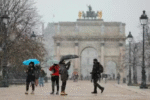Shortly after giving Russia a ten-day deadline to stop the war in Ukraine, U.S. President Donald Trump declared on July 31 that the United States will “impose sanctions” on Moscow due to the lack of progress toward a ceasefire or peace agreement with Kyiv.
At the same time, Trump admitted it’s unclear whether financial penalties will push Russian President Vladimir Putin toward a ceasefire. He told reporters that his special envoy, Steve Witkoff, will travel to Moscow after a visit to Israel, where he arrived on August 1.
If Trump imposes sanctions before or after the ten-day deadline—set to expire on August 8—it would be the first time he penalizes the Kremlin since beginning his second presidential term more than six months ago. During his re-election campaign, Trump promised to quickly broker an end to the largest war in Europe since 1945.
The threat of new sanctions comes as Russia advances on the battlefield and escalates aerial attacks on Ukrainian cities, including a missile and drone strike that killed at least 31 people—five of them children—in Kyiv this past week. Trump called the ongoing attacks “horrific” in his July 31 remarks.
Could This Be a Turning Point in the War?
Will Witkoff Make a Difference?
While Trump suggested sanctions are now inevitable, sending Witkoff to Russia—who has met Putin several times since January—might be a final attempt to move the Kremlin before the deadline expires.
However, this effort seems unlikely to succeed. U.S. Secretary of State Marco Rubio said that unannounced talks this week with “some of Putin’s close allies” failed to make progress toward a peace path.
Three rounds of direct negotiations in Istanbul in May and June also did not bring Russia and Ukraine closer on key issues blocking a ceasefire or comprehensive peace deal.
“Russia won’t make any more concessions,” said Prague-based political analyst Ivan Preobrazhensky on August 1.
“The Kremlin realized Trump has figured out he’s being misled. As a result, Moscow is preparing to sever ties—returning to the posture from about six months ago during Joe Biden’s presidency.”
Still, Putin might view Witkoff’s visit as a chance to pressure the White House to back off sanctions or shift the narrative, blaming Kyiv for the lack of peace progress—something Trump had previously suggested before changing his tone in recent weeks.
Even as Trump increases his criticism of Moscow, he has emphasized that both sides must negotiate and that Ukraine must do “what needs to be done” to end the war.
“Both Russia and Ukraine must negotiate a ceasefire and sustainable peace. It’s time for an agreement,” said John Kelley, acting U.S. representative to the UN, on July 31.
Although Ukraine has agreed to Trump’s proposed ceasefire, Russia has not. Still, Moscow may see an opportunity to pressure Washington into pressing Kyiv for concessions.
What Kind of Sanctions, and Will They Work?
Trump has not specified what sanctions he plans to impose but said they may include “very tough tariffs” on Russia and possibly “secondary sanctions” on countries that trade with Moscow.
According to analysts, direct tariffs on Russia would have limited impact because U.S.-Russia trade volume is low. However, secondary sanctions could be much more significant—especially in oil and gas, Russia’s most profitable exports.
In an interview with Fox News Radio, Secretary Rubio said oil exports bring Russia “a huge portion” of its revenue.
However, such measures carry risks. China, India, and Turkey are Russia’s top crude oil buyers and major clients for its refined products. Secondary sanctions could complicate U.S. relations with those countries.
Meanwhile, the benefits of new sanctions are uncertain, as the Kremlin shows no signs of softening, and China remains uninterested in abandoning its support for Russia’s war effort.
Rubio added that Trump has “many options,” including secondary sanctions on Russian oil sales and sectoral sanctions on banking, which could be very powerful.
Yet, Trump himself downplayed the likelihood that sanctions would deter Putin:
“I don’t know if sanctions bother him,” he said on July 31.
Will Trump Stay Committed or Pull Back?
Beyond sanctions, a crucial question is whether Trump will remain committed to ending the war or shift course, as he and other U.S. officials have repeatedly suggested is possible.
At some point, Trump must decide “whether it’s worth continuing peace efforts if one side isn’t interested,” Rubio said, adding that “it’s clear the president won’t wait indefinitely.”
From the beginning, Trump hinted he might combine sanctions on Russia with support for Kyiv, primarily via weapons, to push both sides toward peace.
But how far Trump is willing to go with arms support remains unclear. On July 14, when he set a 50-day deadline for peace—later shortened to 10 days—he also announced plans to bolster Ukraine’s arsenal, but not via direct U.S. arms shipments.
Instead, Trump proposed that NATO members supply existing weapons, such as Patriot missile systems, to Ukraine and replace them by purchasing new weapons from the U.S. Alternatively, they could buy American arms and send them to Kyiv.
However, it’s uncertain how many weapons will reach Ukraine this way, and how quickly.
As of now, Trump has not authorized new arms shipments through the Presidential Drawdown Authority (PDA) program used extensively by President Biden. When Trump took office, about $4 billion remained under the PDA.
What Happens on the Battlefield?
Ukrainian forces have made little progress since the failed counteroffensive of 2023. Since then, Russia has continued to seize territory, albeit slowly and at high human cost.
When Trump announced the 50-day deadline on July 14, critics warned it could give Russia time to advance further before facing pressure—weakening Ukraine’s negotiating position.
The shorter deadline may alleviate that concern, but analysts agree that Russia lacks the capacity to fully capture the regions it claims—Donetsk, Luhansk, Zaporizhzhia, Kherson, and Crimea—anytime soon.
Nonetheless, Russia shows no signs of pulling back, and there is no indication that the August 8 deadline or impending sanctions will change its posture.
On August 1, AFP reported that Russia launched more drones in July than any month since the 2022 invasion.
That same day, Putin reiterated that Moscow’s objectives remain unchanged, claiming Russian forces are advancing across the front, despite what he described as Western efforts to halt them.
“In the coming months, Russia will increase pressure on Ukraine and likely attempt a new offensive before winter,” said Ivan Preobrazhensky to Current Time, the Russian-language TV network led by Radio Free Europe/Radio Liberty.







